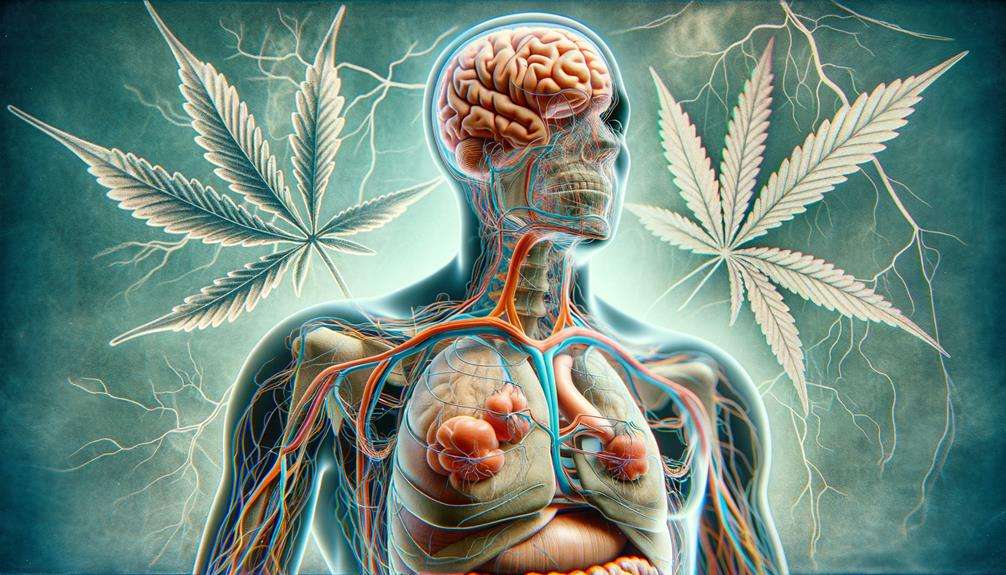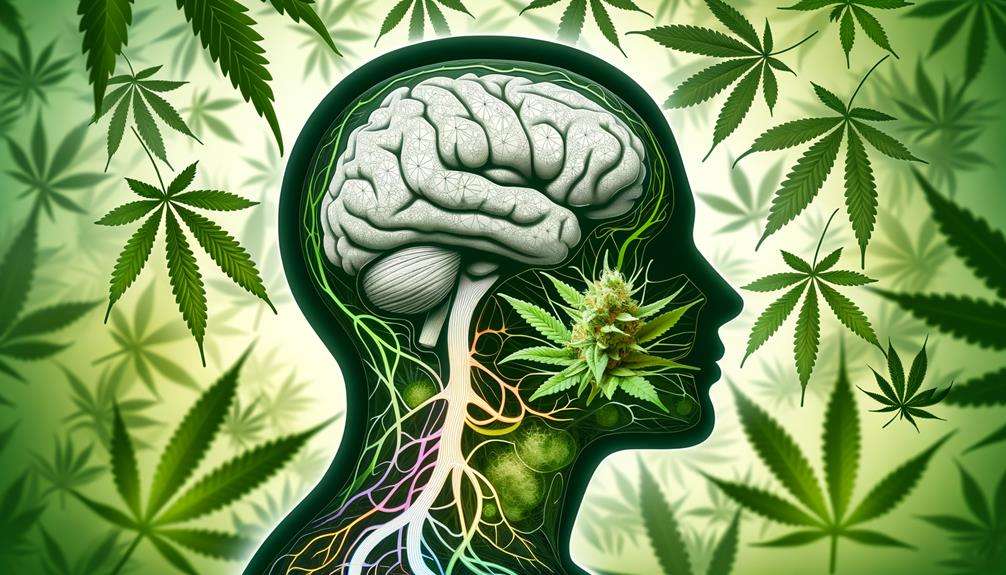Cannabinoid receptors are vital parts of your endocannabinoid system. They’re like keys on the surface of your cells which interact with endocannabinoids and phytocannabinoids. These interactions regulate various bodily functions, including pain perception, mood, appetite and immune response. There are two main types: CB1, primarily in your brain and nervous system, and CB2, found mostly in your immune system. Understanding these receptors can illuminate the effects of cannabis and aid in revealing its potential health benefits. If you’re keen to learn, there’s more to discover about their role in your body’s interactions with cannabis.
What are Cannabinoid Receptors?

You might be wondering, what’re cannabinoid receptors?
They’re part of your body’s endocannabinoid system, acting as the landing sites for cannabinoids both produced by your body and those ingested, like CBD.
Now let’s discuss the two main types, Cannabinoid Receptors 1 (CB1) and Cannabinoid Receptors 2 (CB2), and learn about their locations and functions.
Definition of Cannabinoid Receptors and the Endocannabinoid System
Cannabinoid receptors are integral components of the body’s endocannabinoid system, a complex network that plays a crucial role in regulating various physiological processes. They’re like locks on the surface of your cells, and phytocannabinoids, or plant-based cannabinoids, are the keys.
Companies like Kentucky Cannabis Company, through hemp cultivation, tap into this system by producing phytocannabinoids. These plant-derived compounds can interact with your cannabinoid receptors, potentially influencing your body’s regulation of mood, pain, appetite, and more.
The endocannabinoid system’s broad regulatory role and the potential impact of phytocannabinoids provide an exciting field of research, with the prospect of harnessing these interactions for health and wellness. It’s like accessing your body’s potential with nature’s key.
Learn about the Endocannabinoid System at Bluegrass Hemp Oil
Cannabinoid Receptors 1 (CB1) vs. Cannabinoid Receptors 2 (CB2): Location and Function
Let’s investigate in detail the two primary types of cannabinoid receptors in your body – CB1 and CB2 – and explore their unique locations and functions.
Mainly found in your brain and central nervous system, CB1 receptors play a significant role in managing pain, mood, and appetite.
On the other hand, CB2 receptors are more abundant in your immune system, influencing inflammation and immune response.
When cannabinoids interact with these receptors, they can alter how you perceive pain or react to stress.
Understanding the function and location of these cannabinoid receptors can help you better comprehend how cannabis products might affect you.
It’s a complex system, but each discovery brings us closer to revealing the full potential of cannabinoids.
Living Well With Parkinson’s Disease: a Comprehensive Guide
How Do Cannabinoids Affect Cannabinoid Receptors?
You might wonder how cannabinoids influence your body’s cannabinoid receptors.
It’s a dance between endocannabinoids, which your body naturally produces, and phytocannabinoids, derived from plants like hemp.
Let’s explore how the activation of these receptors can affect various physiological processes in your body.
Endocannabinoids vs. Phytocannabinoids: The Body’s Cannabinoids vs. Plant-Derived Cannabinoids
Understanding how cannabinoids affect your body requires grasping the distinction between endocannabinoids, which your body naturally produces, and phytocannabinoids, which come from plants like hemp. Your body’s cannabinoids, or endocannabinoids, play a crucial role in regulating internal processes like mood, appetite, and sleep. They fit like a key into your body’s cannabinoid receptors, part of your endocannabinoid system.
Conversely, plant-derived cannabinoids, also known as phytocannabinoids, are present in cannabis plants. These external compounds mimic the effects of endocannabinoids, potentially impacting your body’s physiology. While they don’t replace your body’s cannabinoids, they can enhance their effects, which is why they’re often explored for therapeutic purposes.
Understanding these differences helps you appreciate how cannabinoids interact with your body.
Cannabinoid Receptor Activation and its Effects
When cannabinoids enter your body, they bind to specific receptors in your endocannabinoid system (ECS), triggering a variety of physiological responses. These receptors are like locks, and cannabinoids are the keys that activate them. Once activated, they can help your body maintain balance and health.
For instance, they can play a significant role in pain management. By interacting with your ECS, cannabinoids can regulate pain signals, potentially providing relief from chronic discomfort. They also have an impact on inflammation, reducing it and helping your body heal.
Even your mental health can benefit, as cannabinoids can ease anxiety symptoms. Lastly, they can help manage sleep disorders, promoting restful and regular sleep patterns.
Cannabinoid Receptor 1 (CB1): Functions and Potential Applications

You might wonder about the role of Cannabinoid Receptor 1 (CB1) in the human body. Primarily found in the Central Nervous System (CNS), CB1 receptors play an essential role in your body’s reactions to cannabinoids.
Their potential therapeutic applications, such as pain management, could revolutionize healthcare in unique ways.
CB1 Receptor Location and Role in the Central Nervous System (CNS)
Diving deeper into the science of cannabinoids, let’s explore the CB1 receptor, a pivotal component of the endocannabinoid system primarily found in the brain and central nervous system. This receptor plays a vital role in regulating your body’s homeostasis, mood, and perception of pain.
The central nervous system, loaded with CB1 receptors, is a hub for these interactions. These receptors bind with cannabinoids produced naturally by your body, or those introduced from outside sources. That’s where hemp-derived wellness comes into play. Products rich in cannabinoids can interact with your cannabinoid receptors, potentially affecting your overall wellbeing.
Understanding the CB1 receptor’s location and function is essential to grasp how these interactions might contribute to your health.
Potential Therapeutic Applications of Targeting CB1 Receptors (e.g., pain management)
Building on our understanding of CB1 receptors, let’s examine how targeting these essential components can potentially aid in managing conditions like chronic pain.
CBD for pain management has gained traction, with hemp-derived wellness solutions such as Bluegrass Hemp Oil becoming increasingly popular.
You see, CB1 receptors play a significant role in pain modulation. When CBD interacts with these receptors, it could potentially reduce pain sensations.
The potential therapeutic applications don’t stop there. By targeting CB1 receptors, it’s possible to influence other physiological processes, such as mood and appetite regulation.
Exploring the Intersection of Myelin, Phospholipids, and Cannabinoids in MCT Oil
Cannabinoid Receptor 2 (CB2): Functions and Potential Applications
You’re about to explore the world of the CB2 receptor, a pivotal player in your body’s peripheral nervous system. It’s essential to understand its functions and potential therapeutic applications, especially in managing inflammatory conditions.
CB2 Receptor Location and Role in the Peripheral Nervous System (PNS)
Let’s explore the role of the CB2 receptor, primarily found in the peripheral nervous system (PNS), and its potential applications in health and wellness.
The CB2 receptor is a protein structure on cells in your PNS, which plays a key role in immune response and inflammation. When activated by CBD oil, derived from industrial hemp, these receptors can potentially alleviate pain and inflammation.
Kentucky Cannabis Company, a pioneer in hemp production, understands the potential of CB2 receptors and has been at the forefront of exploring their applications. Their CBD oil, cultivated from Kentucky-grown hemp, is designed to interact with these receptors, offering you a natural way to maintain balance in your body.
Everything You Need to Know About CBD Products and How to Use Them
Potential Therapeutic Applications of Targeting CB2 Receptors (e.g., inflammatory conditions)
By targeting CB2 receptors, compounds like CBD could potentially offer therapeutic benefits for inflammatory conditions. Research on CBD oil benefits shows promise in treating ailments such as arthritis and Crohn’s disease.
Quality control is essential for these uses of CBD products. Kentucky hemp, known for its quality, is often used due to its high CBD content. Responsible hemp production guarantees that the CBD oil you use is pure, potent, and free from contaminants.
As more research emerges, we’re learning just how versatile and beneficial CBD can be. But remember, it’s vital to purchase CBD products from a trusted source, one that prioritizes quality control and uses responsibly produced hemp, like that grown in Kentucky.
Understanding CBD Absorption and the Role of MCT Oil
Conclusion: Cannabinoid Receptors and the Future of Cannabinoid Research

As we wrap up, you’re probably realizing how much potential exists in the field of cannabinoid receptor research.
Imagine, with continued exploration and understanding, the medical breakthroughs that could be on the horizon.
It’s an exciting time, and you’re now part of the conversation about the future of cannabinoid research.
The Potential of Cannabinoid Receptor Research for Medical Applications
Exploring the potential of cannabinoid receptor research could revolutionize medical applications, opening avenues for new treatments and therapies. Consider CBD oil, derived from hemp testing and sustainable farming practices. Its interaction with our body’s receptors has led to substantial benefits, making it a key player in medical marijuana applications.
| Potential Medical Applications | Benefits of CBD Oil |
|---|---|
| Pain Management | Alleviates chronic pain |
| Anxiety and Depression | Promotes relaxation and mood improvement |
| Insomnia | Aids in establishing sleep patterns |
Your understanding of the role cannabinoid receptors play in our bodies could be the key to discovering future therapeutic solutions. This field is burgeoning with potential, and the future of cannabinoid research promises exciting prospects.
Discover the source of premium Full Spectrum CBD by visiting Kentucky Cannabis Company, the proud parent company of Bluegrass Hemp Oil.
Frequently Asked Questions
How Does the Body Naturally Produce Cannabinoids?
You’re wondering how your body naturally produces cannabinoids, right?
Well, your body’s endocannabinoid system creates these compounds. They’re essential for maintaining your body’s balance, regulating functions like sleep, mood, and appetite.
Your body produces them as needed, and they interact with cannabinoid receptors. It’s a complex process, but it’s vital for your wellbeing.
Learn about the Endocannabinoid System at Bluegrass Hemp Oil
Are There Any Known Side Effects of Cannabinoids Interacting With Receptors?
Yes, there can be side effects as cannabinoids interact with your body’s receptors. These might include dizziness, dry mouth, changes in appetite, mood alterations, and drowsiness.
However, it’s important to note that everyone’s response to cannabinoids is unique. So, while some people might experience side effects, others may not.
Always consult a healthcare professional before starting any new treatment, especially if you’re taking other medications.
What Role Do Cannabinoids Play in the Immune System?
Cannabinoids play a vital role in your immune system. They interact with your cannabinoid receptors, influencing immune responses. They can help regulate inflammation and may even influence how your body responds to pathogens or diseases.
However, research is ongoing, and it’s not fully clear how these interactions work. You should always consult with a healthcare professional before using cannabinoids for immune health.
Can the Endocannabinoid System Be Influenced by Lifestyle or Dietary Changes?
Imagine you’re a conductor, directing your body’s endocannabinoid system (ECS) orchestra. Your lifestyle choices and diet can influence the tune it plays. Healthy habits like exercise, good nutrition, and stress management help the ECS perform harmoniously, supporting overall well-being.
What type of CBD is Most Effective
Conversely, poor choices may cause discord, impacting your ECS’s function. It’s like fine-tuning a symphony; your actions play a pivotal role in orchestrating your body’s cannabinoid receptors.
Are There Conditions or Diseases That Affect the Endocannabinoid System?
Yes, certain conditions can affect your endocannabinoid system. Diseases like Parkinson’s, MS, and IBS have been linked to alterations in this system.
Stress and diet can also impact it. It’s important to remember, though, that research is ongoing and it’s not fully understood how these diseases interact with your endocannabinoid system.
Always consult with a healthcare professional if you’re dealing with these conditions.
Conclusion
You might be skeptical about the potential of cannabinoid receptors and how they affect your health. But remember, these receptors are part of your body’s intricate system and play a pivotal role in maintaining balance.
As research advances, we’re only scratching the surface of the potential therapeutic benefits. So stick with us, as we continue to unravel the fascinating world of cannabinoids and their potential for your overall well-being.

